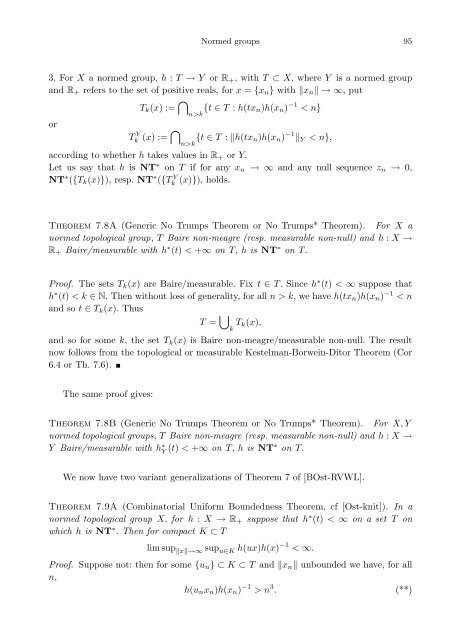Normed versus topological groups: Dichotomy and duality
Normed versus topological groups: Dichotomy and duality
Normed versus topological groups: Dichotomy and duality
Create successful ePaper yourself
Turn your PDF publications into a flip-book with our unique Google optimized e-Paper software.
<strong>Normed</strong> <strong>groups</strong> 953. For X a normed group, h : T → Y or R + , with T ⊂ X, where Y is a normed group<strong>and</strong> R + refers to the set of positive reals, for x = {x n } with ‖x n ‖ → ∞, putorT k (x) := ⋂ n>k {t ∈ T : h(tx n)h(x n ) −1 < n}T Y k (x) := ⋂ n>k {t ∈ T : ‖h(tx n)h(x n ) −1 ‖ Y < n},according to whether h takes values in R + or Y.Let us say that h is NT ∗ on T if for any x n → ∞ <strong>and</strong> any null sequence z n → 0,NT ∗ ({T k (x)}), resp. NT ∗ ({Tk Y (x)}), holds.Theorem 7.8A (Generic No Trumps Theorem or No Trumps* Theorem). For X anormed <strong>topological</strong> group, T Baire non-meagre (resp. measurable non-null) <strong>and</strong> h : X →R + Baire/measurable with h ∗ (t) < +∞ on T, h is NT ∗ on T.Proof. The sets T k (x) are Baire/measurable. Fix t ∈ T. Since h ∗ (t) < ∞ suppose thath ∗ (t) < k ∈ N. Then without loss of generality, for all n > k, we have h(tx n )h(x n ) −1 < n<strong>and</strong> so t ∈ T k (x). ThusT = ⋃ k T k(x),<strong>and</strong> so for some k, the set T k (x) is Baire non-meagre/measurable non-null. The resultnow follows from the <strong>topological</strong> or measurable Kestelman-Borwein-Ditor Theorem (Cor6.4 or Th. 7.6).The same proof gives:Theorem 7.8B (Generic No Trumps Theorem or No Trumps* Theorem). For X, Ynormed <strong>topological</strong> <strong>groups</strong>, T Baire non-meagre (resp. measurable non-null) <strong>and</strong> h : X →Y Baire/measurable with h ∗ Y (t) < +∞ on T, h is NT∗ on T.We now have two variant generalizations of Theorem 7 of [BOst-RVWL].Theorem 7.9A (Combinatorial Uniform Boundedness Theorem, cf [Ost-knit]). In anormed <strong>topological</strong> group X, for h : X → R + suppose that h ∗ (t) < ∞ on a set T onwhich h is NT ∗ . Then for compact K ⊂ Tlim sup ‖x‖→∞ sup u∈K h(ux)h(x) −1 < ∞.Proof. Suppose not: then for some {u n } ⊂ K ⊂ T <strong>and</strong> ‖x n ‖ unbounded we have, for alln,h(u n x n )h(x n ) −1 > n 3 . (**)
















